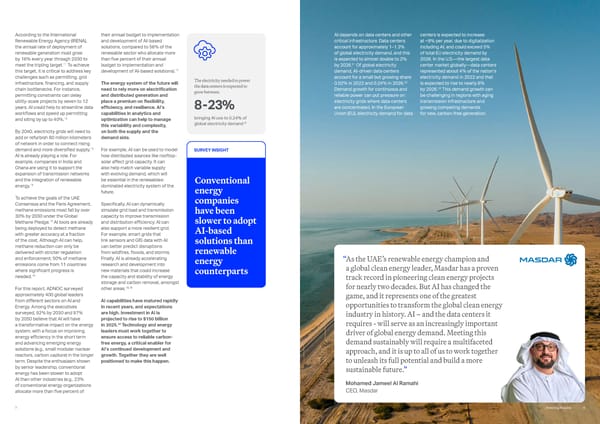“ As the UAE’s renewable energy champion and a global clean energy leader, Masdar has a proven track record in pioneering clean energy projects for nearly two decades. But AI has changed the game, and it represents one of the greatest opportunities to transform the global clean energy industry in history. AI – and the data centers it requires - will serve as an increasingly important driver of global energy demand. Meeting this demand sustainably will require a multifaceted approach, and it is up to all of us to work together to unleash its full potential and build a more sustainable future.” Mohamed Jameel Al Ramahi CEO, Masdar According to the International Renewable Energy Agency (IRENA), the annual rate of deployment of renewable generation must grow by 16% every year through 2030 to meet the tripling target.11 To achieve this target, it is critical to address key challenges such as permitting, grid infrastructure, financing, and supply chain bottlenecks. For instance, permitting constraints can delay utility-scale projects by seven to 12 years. AI could help to streamline data workflows and speed up permitting and siting by up to 40%.12 By 2040, electricity grids will need to add or refurbish 80 million kilometers of network in order to connect rising demand and more diversified supply.13 AI is already playing a role. For example, companies in India and Ghana are using it to support the expansion of transmission networks and the integration of renewable energy.14 To achieve the goals of the UAE Consensus and the Paris Agreement, methane emissions must fall by over 30% by 2030 under the Global Methane Pledge.15 AI tools are already being deployed to detect methane with greater accuracy at a fraction of the cost. Although AI can help, methane reduction can only be delivered with stricter regulation and enforcement; 50% of methane emissions come from 11 countries where significant progress is needed.16 For this report, ADNOC surveyed approximately 400 global leaders from different sectors on AI and Energy. Among the executives surveyed, 92% by 2030 and 97% by 2050 believe that AI will have a transformative impact on the energy system, with a focus on improving energy efficiency in the short term and advancing emerging energy solutions (e.g., small modular nuclear reactors, carbon capture) in the longer term. Despite the enthusiasm shown by senior leadership, conventional energy has been slower to adopt AI than other industries (e.g., 23% of conventional energy organizations allocate more than five percent of their annual budget to implementation and development of AI-based solutions, compared to 56% of the renewable sector who allocate more than five percent of their annual budget to implementation and development of AI-based solutions).17 The energy system of the future will need to rely more on electrification and distributed generation and place a premium on flexibility, efficiency, and resilience. AI’s capabilities in analytics and optimization can help to manage this variability and complexity, on both the supply and the demand side. For example, AI can be used to model how distributed sources like rooftop- solar affect grid capacity. It can also help match variable supply with evolving demand, which will be essential in the renewables- dominated electricity system of the future. Specifically, AI can dynamically simulate grid load and transmission capacity to improve transmission and distribution efficiency. AI can also support a more resilient grid. For example, smart grids that link sensors and GIS data with AI can better predict disruptions from wildfires, floods, and storms. Finally, AI is already accelerating research and development into new materials that could increase the capacity and stability of energy storage and carbon removal, amongst other areas.18,19 AI capabilities have matured rapidly in recent years, and expectations are high. Investment in AI is projected to rise to $150 billion in 2025.20 Technology and energy leaders must work together to ensure access to reliable carbon- free energy, a critical enabler for AI’s continued development and growth. Together they are well positioned to make this happen. AI depends on data centers and other critical infrastructure. Data centers account for approximately 1–1.3% of global electricity demand, and this is expected to almost double to 2% by 2026.21 Of global electricity demand, AI-driven data centers account for a small but growing share: 0.02% in 2022 and 0.24% in 2026.22 Demand growth for continuous and reliable power can put pressure on electricity grids where data centers are concentrated. In the European Union (EU), electricity demand for data centers is expected to increase at ~9% per year, due to digitalization including AI, and could exceed 5% of total EU electricity demand by 2026. In the U.S.—the largest data center market globally—data centers represented about 4% of the nation’s electricity demand in 2022 and that is expected to rise to nearly 6% by 2026.23 This demand growth can be challenging in regions with aging transmission infrastructure and growing competing demands for new, carbon-free generation. Conventional energy companies have been slower to adopt AI-based solutions than renewable energy counterparts SURVEY INSIGHT The electricity needed to power the data centers is expected to grow between bringing AI use to 0.24% of global electricity demand 9 8 - 23% 8 Powering Possible 7
 Powering Possible 2024: AI and Energy for a Sustainable Future Page 4 Page 6
Powering Possible 2024: AI and Energy for a Sustainable Future Page 4 Page 6